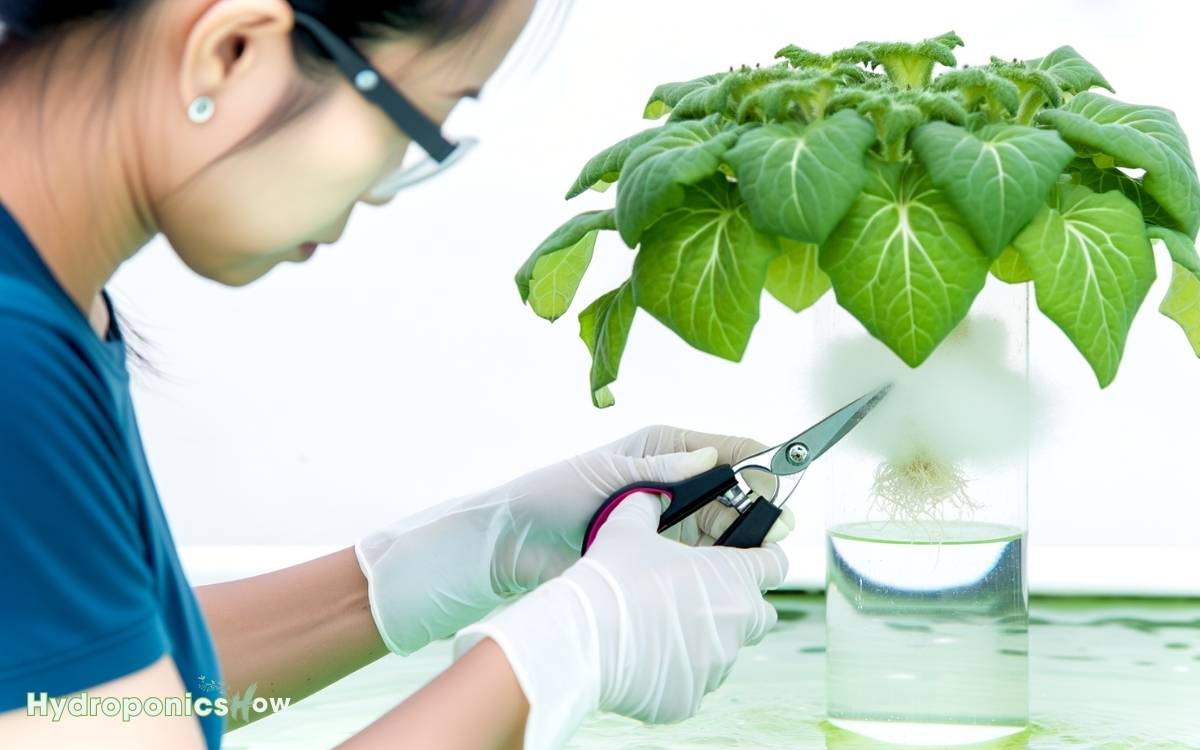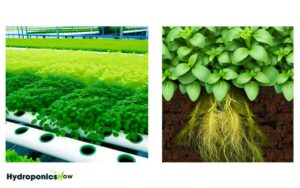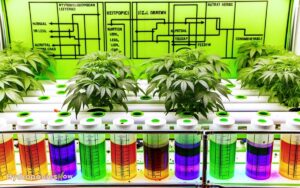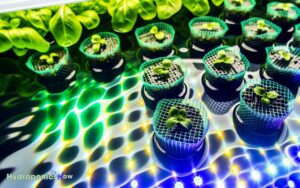Guide: You Trim Roots for Optimal Hydroponic Plants Yes
Yes, you can trim the roots of hydroponic plants. Regular root trimming is necessary for entangled, decaying, or overgrown roots and promotes excellent plant health.
Utilize sterilized pruning shears or sharp scissors for clean cuts, removing no more than 20-30% of the root mass to minimize stress.
Post-trimming care should include monitoring nutrient levels, maintaining water quality, and enhancing oxygenation.
Be cautious to avoid introducing pathogens and over-trimming, as these can hinder growth or damage the plant.
Understanding these practices can greatly improve the efficiency and success of your hydroponic system. Continue to explore for detailed methods and best practices.

Key Takeaways
Importance of Root Health
Maintaining peak root health is paramount in hydroponic systems, as it directly influences nutrient uptake, plant growth, and overall yield.
Peak root health guarantees efficient absorption of water, oxygen, and essential nutrients, which are critical for robust plant development.
In hydroponics, roots are more exposed to environmental variables, making them susceptible to diseases and nutrient imbalances. Regular monitoring of root color, texture, and smell can provide early indicators of potential issues.
Additionally, maintaining proper oxygenation and avoiding root zone stagnation are vital for preventing root rot and promoting healthy growth.
Utilizing beneficial microbes can further enhance root resilience by supporting a balanced microbial ecosystem.
Therefore, vigilant root care is indispensable for achieving superior hydroponic crop performance.
When to Trim Roots
Knowing the best times to trim roots is essential for sustaining plant vitality and maximizing hydroponic system efficiency.
Root trimming is typically necessary when roots become entangled, exhibit signs of decay, or overgrow their allocated space. Regular monitoring is important to determine the best trimming interval.
Below is a concise guide for the ideal timing:
| Condition | Signs of Need for Trimming | Recommended Action |
|---|---|---|
| Root Entanglement | Roots intertwining excessively | Trim to untangle |
| Signs of Decay | Brown, mushy, or foul-smelling roots | Remove decayed sections |
| Overgrowth | Roots clogging system components | Prune to appropriate length |
Tools for Trimming
Selecting the right tools for trimming hydroponic plant roots is essential for ensuring clean cuts and promoting healthy growth. Essential tools include sterilized pruning shears, sharp scissors, and root trimmers.
Regular maintenance of these tools, along with adherence to safety precautions, will enhance their effectiveness and longevity.
Essential Trimming Tools
To effectively trim hydroponic plant roots, precision tools such as sterilized pruning shears, sharp scissors, and clean, fine-toothed saws are essential. These tools guarantee clean cuts that minimize plant stress and potential infection.
Properly chosen tools can greatly enhance the efficacy of the trimming process, ensuring peak plant health and growth.
Key tools include:
- Sterilized pruning shears: Ideal for precise cuts, reducing the risk of pathogen transfer.
- Sharp scissors: Useful for making small, detailed cuts.
- Fine-toothed saw: Necessary for trimming larger root masses with minimal damage.
- Tweezers: Helpful for removing small root fragments.
- Sterilizing solution: Ensures all tools remain clean and free from contaminants.
Selecting the correct tools is crucial for successful hydroponic root maintenance.
Tool Maintenance Tips
Regular maintenance of trimming tools is essential to guarantee their longevity and peak performance.
Begin by thoroughly cleaning blades after each use to prevent sap and residue buildup, which can hinder cutting efficiency. Utilize a soft brush and warm, soapy water for best results.
Next, make sure blades are sharpened regularly using a sharpening stone or specialized tool to maintain a clean cut and avoid damaging plant roots.
Additionally, lubricating pivot points with a few drops of oil will keep the mechanisms smooth and reduce wear.
Safety Precautions
Securing the safety of your trimming process involves more than just maintaining tools; it also requires adhering to specific precautions to protect both the user and the plants.
Proper handling and the use of appropriate safety gear can prevent accidents and guarantee the health of your hydroponic system.
Consider the following safety measures:
- Wear gloves to protect your hands from potential cuts and contamination.
- Use sterilized tools to prevent the introduction of pathogens to the hydroponic environment.
- Ensure adequate lighting to accurately see what you are trimming.
- Work in a clean area to minimize the risk of introducing contaminants.
- Handle plants gently to avoid unnecessary stress or damage to the roots.
These precautions are essential for maintaining a safe and effective trimming process.
Step-by-Step Guide
In this step-by-step guide, we will outline the necessary tools required for root trimming and provide a precise trimming technique to promote peak plant health.
Beginning with the appropriate selection of sterilized scissors and gloves, the process will then focus on the correct method to trim roots without causing stress to the plant.
Following these guidelines will encourage healthy root development and efficient nutrient absorption.
Necessary Tools Required
To effectively trim hydroponic plant roots, you will require a specific set of tools designed for precision and safety. Selecting the correct tools guarantees that the roots are trimmed cleanly, promoting healthy regrowth and preventing damage to the plant.
Each item listed is essential for maintaining peak plant health and achieving precise cuts.
- Sterilized Scissors or Pruning Shears: Essential for making clean cuts without causing root damage.
- Clean Work Surface: Prevents contamination and keeps the trimming area organized.
- Disinfectant Solution: Used to sterilize tools before and after use to avoid disease transmission.
- Protective Gloves: Ensures hygiene and protects hands from potential irritants.
- Magnifying Glass: Helps in closely inspecting roots for precise trimming.
These tools collectively facilitate an efficient and safe root trimming process.
Proper Trimming Technique
Begin the root trimming process by gently removing the plant from its hydroponic system, ensuring minimal disturbance to the root structure.
- Carefully rinse the roots with lukewarm water to remove any debris.
- Using sterilized, sharp scissors, identify and trim away any brown or mushy roots, as these indicate decay.
- Focus on cutting no more than 20-30% of the total root mass to avoid stressing the plant.
- Make clean cuts to prevent pathogen entry.
- After trimming, inspect the roots for uniformity and health.
- Reintroduce the plant into the hydroponic system, ensuring proper nutrient and oxygen flow.
Maintain an ideal pH level and monitor the plant closely for signs of recovery or stress.
Benefits of Root Trimming
Trimming the roots of hydroponic plants enhances nutrient uptake efficiency, promoting healthier and more vigorous growth. This practice offers several tangible benefits for hydroponic systems, optimizing plant health and productivity.
- Enhanced Aeration: Pruned roots allow for better oxygen flow, important for root respiration and overall plant vitality.
- Disease Prevention: Removing diseased or dead roots reduces the risk of pathogens spreading, ensuring a healthier root system.
- Space Management: Controlled root size prevents overcrowding, facilitating better root distribution and nutrient access.
- Improved Water Absorption: Shorter roots can absorb water more efficiently, which is significant in a hydroponic setup.
- Stimulated Growth: Regular trimming encourages the growth of new, more active root tips, enhancing the plant’s ability to absorb nutrients effectively.
Effective root management is integral to the success of hydroponic cultivation.
Risks to Consider
While root trimming offers numerous benefits, it also presents several risks that must be carefully managed to guarantee the health and productivity of hydroponic plants.
Improper cutting techniques can lead to plant shock, greatly stunting growth or even causing death.
Additionally, trimming can inadvertently introduce pathogens, such as bacteria or fungi, that may exploit the open wounds, leading to infections.
Another critical risk is over-trimming, which can reduce the plant’s ability to absorb essential nutrients and water, thereby compromising its overall vitality.
It’s also essential to recognize that different plant species have varying tolerances to root pruning.
Consequently, growers must exercise precision and caution, employing sanitized tools and adhering to best practices to mitigate these risks effectively.
Post-Trimming Care
Proper post-trimming care is essential to guarantee the rapid recovery and sustained health of hydroponic plants.
After root trimming, it is important to provide an ideal environment to facilitate the healing process and promote robust growth.
Here are critical steps to follow:
- Monitor Nutrient Levels: Make sure the hydroponic solution maintains balanced nutrient concentrations to support recovery.
- Maintain Water Quality: Regularly check and adjust pH levels to prevent stress on the trimmed roots.
- Enhance Oxygenation: Improve oxygen supply to the root zone using air stones or diffusers.
- Control Temperature: Keep the nutrient solution at an ideal temperature (65-75°F) to avoid thermal stress.
- Minimize Light Stress: Initially reduce light intensity to help the plant focus energy on root regeneration.
Adhering to these guidelines will ensure a thriving hydroponic system post-trimming.
Common Mistakes
Despite the critical steps for post-trimming care, several common mistakes can hinder the recovery and growth of hydroponic plants.
One frequent error is over-trimming, which can severely stress the plant, leading to stunted growth or even death.
Additionally, improper sterilization of trimming tools can introduce pathogens, causing infections.
Inadequate nutrient solution adjustments post-trimming can also impede recovery; plants require balanced nutrients to heal efficiently.
Another pitfall is neglecting oxygenation; insufficient dissolved oxygen in the water can suffocate the roots.
Lastly, failing to monitor pH levels can create an inhospitable environment for nutrient uptake.
Conclusion
To sum up, maintaining peak root health in hydroponic systems is crucial for plant vitality. Root trimming, when executed with precision and appropriate tools, can enhance nutrient uptake and promote vigorous growth.
Surprisingly, studies indicate that root pruning can increase hydroponic crop yields by up to 20%. However, the procedure must be performed with caution to avoid potential risks. This technique helps stimulate root branching, leading to more efficient nutrient and water absorption. When growers transplant hydroponic plants to soil, careful root pruning can ease the transition and promote healthier root development. However, excessive pruning may stress the plants, potentially reducing overall growth and yield.
Post-trimming care and vigilant monitoring are imperative to guarantee successful recovery and sustained plant health.






